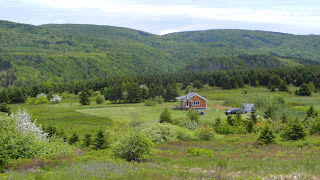Authentically restored, the lighthouse keeper's quarters show the spartan life of a lighthouse keeper. The guide graciously offered tea - hot, of course.
Back on the TransCan, we found Sea Breeze RV on Shallow Bay, just a stone's throw from our next geocache. It was getting colder and wetter, so we decided to wait for the next day to search for the cache. In "town", we had dinner overlooking the bay and it is shallow as evidenced by the receding tide. I had my first taste of Bakeapple on ice cream. It's not an apple, nor is it baked. It is a raspberry-like berry the color of an apricot that grows on low-lying bushes between the rocks. It wasn't until much later in the trip that a guide pointed out the bushes. The berries usually appear in August.
Not feeling so great after the day's outing in the cold and wet the day before, we skipped going after the Cow Head geocache. Instead we stopped off at the Port Au Chois Historic Site. Spread out over 3-4 kms, several Dorset and Beothuk archaeological sites dot the landscape. We were told to watch for caribou. Okay, bears, moose, caribou....
I was impressed with one of the guides from Montreal who told just how special it felt to him to be on this land overlooking the sea that had provided food and shelter for thousands of years. I began to get it. Newfoundland's shores have been inhabited for thousands of years because of its unique location. Ancient Eskimos travelled long distances to fish the rich waters. The land provided shelter. A 1000 years ago, the Vikings discovered it and for generations, French fishermen came as the seasons allowed to fish and then sell their dried, salted fish in the Caribbean and in Europe. And then some stayed, followed by the British.
 |
| Sea Breeze RV on Shallow Bay |
 |
| Port Au Chois Meditative Point |
Listening to weather reports, we realized that Newfoundland was to receive more rain in the next few days, so we opted to take the ferry to Labrador. We waited for the 3:30 pm ferry along with a few others at the terminal/motel/restaurant. Moving up to the lounge near the bow of the ship we watched patiently for any sight of a whale. Briefly and I mean briefly, we caught just a partial view of one as it slid back into the water.
The news reported that the eastern shores of Newfoundland were disappearing in dense fog, but the NE winds were blowing icebergs ashore. My heart fell; I just knew they would all be blown out to sea by the time we returned and worked our way around to the east. But, I was totally taken by surprise when the white speck I saw in the distance proved to be an iceberg! Yes, of course, Labrador has an eastern shore, too. Things were looking up.














































